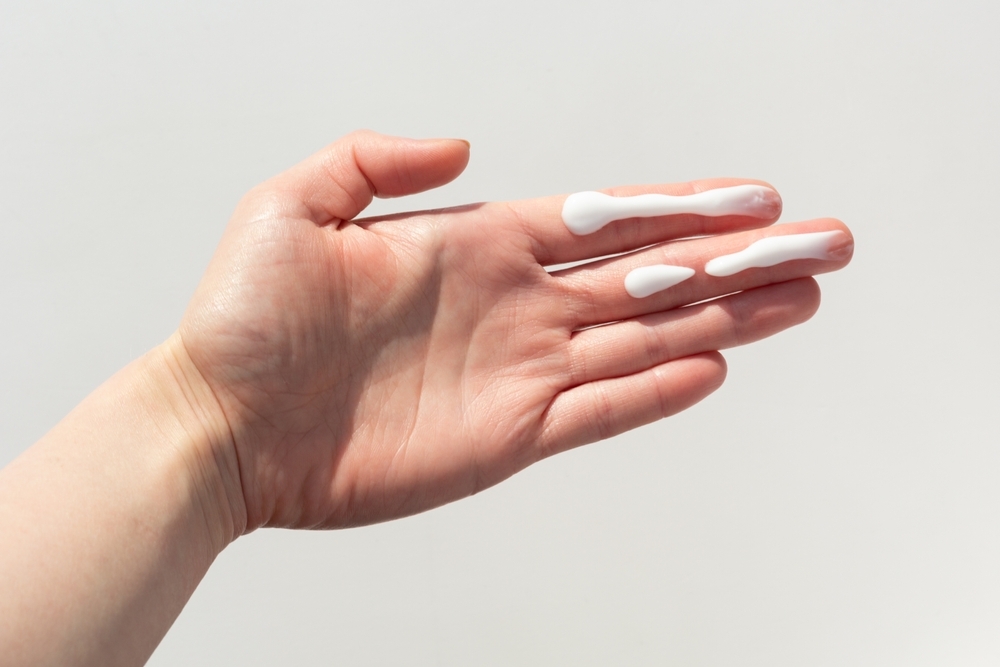When it comes to quantity, most of what you know about sunscreen application best practices probably involves the body. And while this likely won't come as a shock, the amount of sunscreen you should use on your face is different than what you would use for the rest of your body. A few different rules can help you remember how much sunscreen to use on your face, and following them can minimize your risk of sun damage.
From unpacking the teaspoon rule of sunscreen to learning how to choose a facial formula that works for you, read on to walk confidently under the sun.
How Much Sunscreen Should You Apply to Your Face?
You may be familiar with the golden sunscreen rule of using a shot glass amount—about one liquid ounce or two tablespoons—for your entire body. But when it comes to how much sunscreen to use on your face alone, similar methods can help you get the coverage you need.
Lotion
For lotions and other liquid sunscreen formulations, the Skin Cancer Foundation suggests using a nickel-sized dollop for your face. You can also approximate this amount by spreading sunscreen along the length of your pointer and middle fingers. This method assumes your finger size is proportional to the size of your face. In some cases, you may need to cover three fingers.
And then there's the teaspoon rule of sunscreen application. This breaks down recommended amounts by teaspoon, totaling nine teaspoons from head to toe:
- One teaspoon of sunscreen for the face, head, and neck
- One teaspoon each to the upper extremities (arms)
- One teaspoon each to the front torso and the back torso
- Two teaspoons each to the lower extremities (legs)
A nickel-sized dollop is closer to a half teaspoon, so the teaspoon rule suggests using slightly more than the Skin Cancer Foundation. Ultimately, just make sure you're not using less than a nickel-sized dollop for your face.
Spray
For sunscreen sprays, the American Academy of Dermatology (AAD) recommends applying enough to achieve an even sheen.
Stick
For stick sunscreens, even application is key. The AAD says to aim for four passes back and forth, and then rub it in to ensure even coverage.
What's the Result of Using Too Much or Too Little?
Not using enough sunscreen on your face can lead to sunburn, which can cause inflammation, redness, and dryness. At worst, sunburn increases your risk of skin cancers like melanoma and basal cell carcinoma. Unprotected (or improperly protected) facial skin is also vulnerable to other forms of sun damage, including wrinkles, dark spots, and uneven texture.
Using too much sunscreen is better than not using enough, but it's a waste of product and can lead to pilling. So, make sure you're using the right amount and follow the basic sunscreen application rules.
How Can You Pick the Right Facial Sunscreen?
Picking the right sunscreen for your face means considering a few essential factors.
SPF
Make sure your broad-spectrum sunscreen has the right SPF. According to the Skin Cancer Foundation, you should use a sunscreen with SPF 15 or higher for regular daily use and SPF 30 or higher for prolonged outdoor activities. This rule applies to both face and body sunscreen.
Skin Type
Your skin type—dry, oily, combination, or mature—will determine what ingredients and texture you should look for in a sunscreen. For example, if you're prone to dryness, choose a sunscreen with hydrating ingredients like Hyaluronic Acid or Glycerin. If you have oily skin, opt for a lightweight, noncomedogenic formula to avoid extra shine and pesky breakouts. EltaMD UV Clear Broad-Spectrum SPF 46 meets these guidelines plus Niacinamide to reduce the appearance of blemishes and discoloration.
Lifestyle
If you'll be out in the sun all day or plan to be active (on land or in water), choose a water-resistant sunscreen formula. This will help ensure your protection stays put until you reapply—typically for either 40 or 80 minutes.
Personal Preference
You can choose from a physical (mineral) sunscreen, chemical sunscreen, or hybrid formula. Physical sunscreen contains ingredients like Titanium Dioxide and Zinc Oxide to block and scatter ultraviolet rays before they penetrate the skin. Chemical sunscreen absorbs the rays before they can damage the skin. One isn't necessarily better than the other—it's all about your personal preference and what best supports your skin. You also have the option of tinted sunscreen or untinted sunscreen.
Facing the Day with Confidence
The next time you go to apply sunscreen to your face, know you've got options. Whether you use the finger trick, teaspoon rule, or nickel-sized dollop method, the important thing is to be mindful of how much you're using and follow the proper application practices to ensure even, thorough coverage. A little effort goes a long way when it comes to your skin health.
